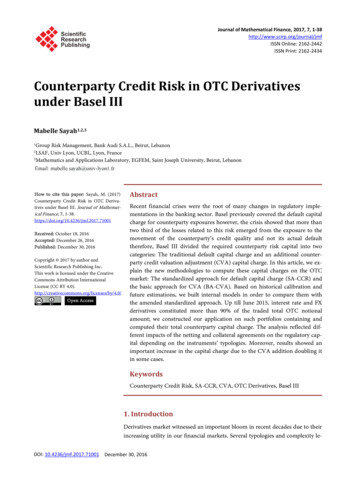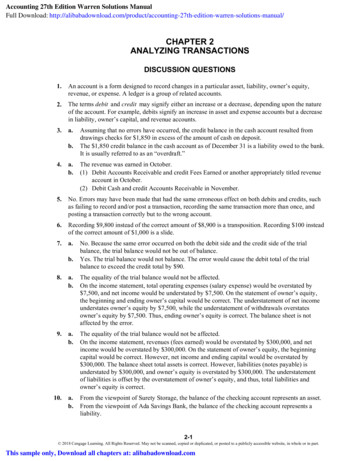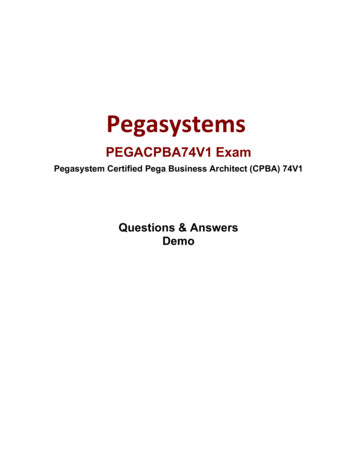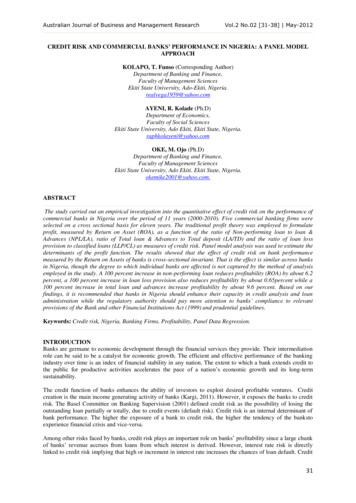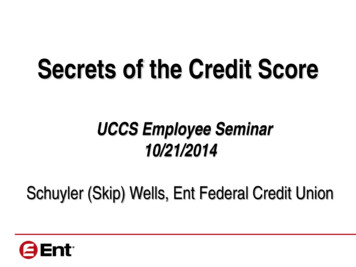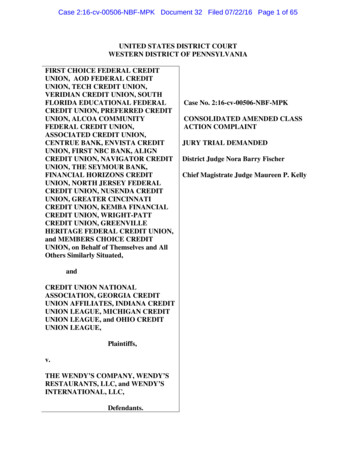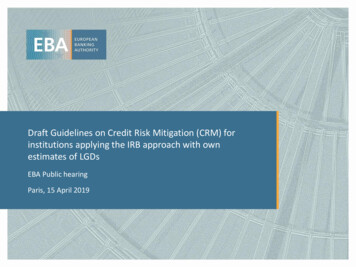
Transcription
Draft Guidelines on Credit Risk Mitigation (CRM) forinstitutions applying the IRB approach with ownestimates of LGDsEBA Public hearingParis, 15 April 2019
GL on CRM in the context of IRB roadmapPrioritisationRegulatory productsCurrent statusPhase 1: AssessmentmethodologyRTS on IRB assessment methodologyFinalised and awaiting COM Phase 2: Definition of RTS on materiality thresholddefaultGL on default of an obligorPhase 3: RiskparametersPhase 4: Credit riskmitigationFinalised and in force Finalised and in force GL on PD estimation, LGD estimationFinalised and in force and the treatment of defaulted exposuresRTS on economic downturnGL on LGD downturn estimationFinalised and awaiting COM Finalised RTS on conditional guaranteesRTS on liquid assetsRTS on master netting agreementsPostponed – broaderconsiderations on CRMframework necessaryNew initiative:Report on CRM under SA and F-IRBGL on CRM under A-IRBFinalised Consultation stageDraft Guidelines on Credit Risk Mitigation for institutions applying the IRB approach with own estimates of LGDs2
Background – why do we need the guidelines? The GLs are developed in response to industry’s feedback, as well as the analysiscarried out by the EBA in the context of the CRM report, which outlined thecomplexity of the current CRR on the CRM framework: Significant variability in the practices Necessity to clarify the requirements and their applicability under differentapproaches The Guidelines on CRM under the Advanced IRB Approach (A-IRB) complement theCRM report which was focused on the Standardised Approach (SA) and theFoundation IRB Approach (F-IRB). The Guidelines on CRM complement the Guidelines on the PD and LGD estimationand the treatment of defaulted exposures.Draft Guidelines on Credit Risk Mitigation for institutions applying the IRB approach with own estimates of LGDs3
Interactions with Basel III standards The final Basel III framework introduces certain adjustments to thetreatment and eligibility criteria of CRM techniques for all approaches: Non-eligibility of conditional guarantees and nth-to-default derivatives Adjustments to the eligibility of immovable properties with junior liens Recognition of the effects of unfunded credit protection (UFCP) though the useof the approach which would be applied to direct exposures to the protectionprovider Deletion of double-default formula Treatment of the Basel III reform in the GL on CRM All provisions in the GL on CRM are consistent with the current CRR Any elements related to the Basel reform or which could lead to inconsistencieswith the final Basel III standards are out of the scope of the GL Aspects related to the Basel reform will be addressed in the EBA’s response tothe Call for Advice from the Commission with regard to Basel III implementationDraft Guidelines on Credit Risk Mitigation for institutions applying the IRB approach with own estimates of LGDs4
Treatment UFCP: Basel III related issuesDraft Guidelines on Credit Risk Mitigation for institutions applying the IRB approach with own estimates of LGDs5
Structure of the GuidelinesThe Guidelines are split into three main sections:1. General provisions, aimed at clarifying the applicability of the current CRRrequirements to the A-IRB Approach; clarifications include different forms ofCRM, namely funded credit protection (FCP) and unfunded credit protection(UFCP)2. Eligibility requirements, providing detailed guidance on the eligibilityrequirements for FCP and UFCP under A-IRB Approach.3. Effects of credit risk mitigation, providing detailed guidance on how institutionscould recognise the effects of eligible FCP and UFCP in the risk parameters;clarifications include also the treatment of ineligible credit protection.Draft Guidelines on Credit Risk Mitigation for institutions applying the IRB approach with own estimates of LGDs6
General provisionsDraft Guidelines on Credit Risk Mitigation for institutions applying the IRB approach with own estimates of LGDs7
Overview of CRM techniques for A-IRB ApproachCRM techniquesFunded Credit Protection (FCP)Through exposure value formaster netting agreement(MNA) and on-balance sheetnetting (OBSN):in accordance with Articles166(2)-(3) and Chapter 4 ofthe CRRThrough LGD adjustments forFCP other than MNA andOBSN :in accordance with Articles181(1)(c)-(g) of the CRRUnfunded Credit Protection (UFCP)Through PD and/or LGDadjustmentsin accordance with Articles 160(5),163(4), 161(3), 164(2) and 183(1)(3) of the CRRDraft Guidelines on Credit Risk Mitigation for institutions applying the IRB approach with own estimates of LGDsThrough "doubledefault" formulain accordance withArticles 153(3) and154(2) of the CRR8
General provisions Main clarifications regarding applicability of requirements:Article 108: under A-IRB Approach CRM recognised in accordance withChapter 3, under F-IRB Approach in accordance with Chapter 4 Requirements for A-IRB Approach: 160(5), 161(3), 164(2)-(3) Requirements not applicable under A-IRB Approach: 160(4), 161(1) The term collateral in Article 181(1) is understood as FCP other than netting. FCP other than netting: Article 181(1) FCP MNA and OBSN: Article 166(2) and (3) UFCP: Article 183 On-balance sheet netting (OBSN) and master netting agreements (MNA)should be recognised only through exposure value and according to botheligibility and treatment requirements of Chapter 4. Credit insurance may be treated in accordance with Article 183 as a guaranteeor credit derivative, where it effectively functions in an equivalent manner(the definition of UFCP has to be met). Draft Guidelines on Credit Risk Mitigation for institutions applying the IRB approach with own estimates of LGDs9
Eligibility requirementsDraft Guidelines on Credit Risk Mitigation for institutions applying the IRB approach with own estimates of LGDs10
Eligibility requirements for funded credit protection Mapping to legal certainty and collateral valuation requirements of Chapter 4 Legal certainty – the collateral is legally effective and legally enforceable in allrelevant jurisdictions, giving the institution the right to liquidate or repossessthe collateral in a reasonable timeframe, also in the event of the default,bankruptcy or insolvency of the obligor Valuation – the rules governing the revaluation of the collateral, includingmethods and frequency of the monitoring of the value of the collateral, areconsistent for each type of collateral Written legal opinion to verify enforceability and legal effectiveness of each typeof collateral and in all relevant jurisdictions Relevant jurisdictions for physical movable collateral: Place of incorporation of the institution and the obligor Law governing the collateral agreement Place of registration of collateral or incorporation of the owner Jurisdictions where the collateral could move during the lifetime of the loanDraft Guidelines on Credit Risk Mitigation for institutions applying the IRB approach with own estimates of LGDs11
Eligibility requirements for unfunded credit protection Written legal opinion to verify enforceability and legal effectiveness of eachtype of unfunded credit protection and in all relevant jurisdictions single legal opinion may support multiple credit protection arrangements wherethe legal opinion relates to the same applicable law legal opinion relating to any substantive variation to the terms of the contract legal counsel may be an employee of the institution Defaulted guarantor is ineligibleDraft Guidelines on Credit Risk Mitigation for institutions applying the IRB approach with own estimates of LGDs12
Effects of credit risk mitigationDraft Guidelines on Credit Risk Mitigation for institutions applying the IRB approach with own estimates of LGDs13
Effects of credit risk mitigation - FCPThe EBA Guidelines on PD and LGD estimation and the treatment of defaulted exposuresalready provide guidance on the recognition of collateral in LGD models and hence lessfocus is given to that topic in the GL on CRM. In the context of FCP the GL on CRM provideadditional clarifications on the treatment of OBSN and MNA. How to recognise OBSN and MNA in exposure value and avoid doublecounting?𝐿𝐺𝐷 𝐿𝐺𝐷 𝐸 𝐸where: LGD is an own estimate, where in risk quantification realized LGD is computed based on theadjusted exposure value, internal cash flows based on netting are not taken into account E* is computed in accordance with Chapter 4 CRR E is a gross exposure value in accordance with Article 166 CRR as if not collateralized Risk weighted exposure amounts are computed based on LGD* and E*Draft Guidelines on Credit Risk Mitigation for institutions applying the IRB approach with own estimates of LGDs14
Methods for the recognition of UFCP1) Adjustment of PD and LGD according to 160(5), 161(3) and 164(2)according to the criteria of 183(2) and (3) Modelling approach adjustment of LGD (including LGD in-default and ELBE) under certain conditions both PD and LGD (never sole adjustment ofPD) Substitution approach both PD and LGD parameters should be substituted subject to eligibility requirements of Chapter 4 Override for individual cases in the application of the modelRisk weight floor applies in all casesDraft Guidelines on Credit Risk Mitigation for institutions applying the IRB approach with own estimates of LGDs15
Methods for the recognition of UFCP - cont.2) Substitution of the risk weight with the risk weight of the guarantor inaccordance with Article 183(4) In the case direct exposures to the guarantor are treated under the SA Subject to eligibility criteria specified in Article 183(4)3) Double default formula in accordance with Articles 161(4), 164(3), 153(3)and 154(2) Subject to eligibility criteria specified in Articles 202 and 217Optionality in the use of methodsDraft Guidelines on Credit Risk Mitigation for institutions applying the IRB approach with own estimates of LGDs16
Substitution of risk parameters – further clarifications General requirement for the use of substitution approach clear policies on the scope of application of the substitution approach andmethods to derive parameters applicable to comparable direct exposure to theguarantor separate scope of application of the LGD model for the guaranteed part of theexposure to which substitution approach is not applied all data relevant for PD and LGD estimation should be stored in the institution’sreference data set PD of the obligor must be estimated; no need to estimate LGD Selected application issues allocation cash flows and costs in case of partial guarantees multiple CRM techniques covering the same exposure backtesting of the substitution approach based on EL rather than PD and LGD separatelyDraft Guidelines on Credit Risk Mitigation for institutions applying the IRB approach with own estimates of LGDs17
Substitution and modelling approach – further clarificationsHierarchy of methods for deriving LGD adequate to comparable directexposure to the protection provider, for exposures secured by UFCP and FCP– both for substitution and for the risk weight floor:Exposure to obligor secured by both UFCP and FCPGuarantor under F-IRBRegulatory LGD,taking intoaccountcollateralGuarantor under A-IRBIt is possible to reflectFCP in the LGD modelapplicable to theguarantorIt is not possible to reflect FCPin the LGD model applicable tothe guarantor𝒈𝒖𝒂𝒓𝒂𝒏𝒕𝒐𝒓Own estimate of LGD asfor direct exposures � ��𝑮𝑫𝒖𝒏𝒔𝒆𝒄𝒖𝒓𝒆𝒅 n estimate of LGD forthe exposure to obligorRegulatory LGD as inChapter 4 CRRDraft Guidelines on Credit Risk Mitigation for institutions applying the IRB approach with own estimates of LGDs18
Other issues under consideration Recognition of portfolio guarantees under A-IRB Approach Is portfolio guarantee eligible form of collateral? Various possible structures of the guarantee1. Losses covered if above a threshold2. Losses covered up to a threshold3. Complex structure combining more than one threshold Article 234 CRR not applicableDefinition of securitisation in accordance with point (61) of Article 4(1) CRR Is it possible to adequately reflect portfolio guarantee in LGD model? Is sufficient data available? How to allocate the portfolio effect to individual facilities? How to reflect the effect of downturn conditions?Draft Guidelines on Credit Risk Mitigation for institutions applying the IRB approach with own estimates of LGDs19
Expected timelines Expected timelines for finalising the Guidelines Publication of the Consultation Paper – 25 February 2019End of the consultation period – 25 May 2019Analysis of responses – Q3 / Q4 2019 (tentative)Final Guidelines – Q4 2019 / Q1 2020 (tentative) Expected timelines for implementation of the Guidelines Implementation date aligned with the timelines for the IRB roadmap in order toavoid multiple changes in the rating systems where possible Final implementation deadline including supervisory approval where necessary(together with other changes based on IRB roadmap) – end 2020 (currentlyenvisaged)Draft Guidelines on Credit Risk Mitigation for institutions applying the IRB approach with own estimates of LGDs20
EUROPEAN BANKING AUTHORITYFloor 46, One Canada Square, London E14 5AATel: 44 207 382 1776Fax: 44 207 382 1771E-mail: info@eba.europa.euhttp://www.eba.europa.eu
Draft Guidelines on Credit Risk Mitigation (CRM) for institutions applying the IRB approach with own estimates of LGDs EBA Public hearing Paris, 15 April 2019. . Necessity to clarify the requirements and their applicability under different approaches The Guidelines on CRM under the Advanced IRB Approach (A-IRB) complement the .

